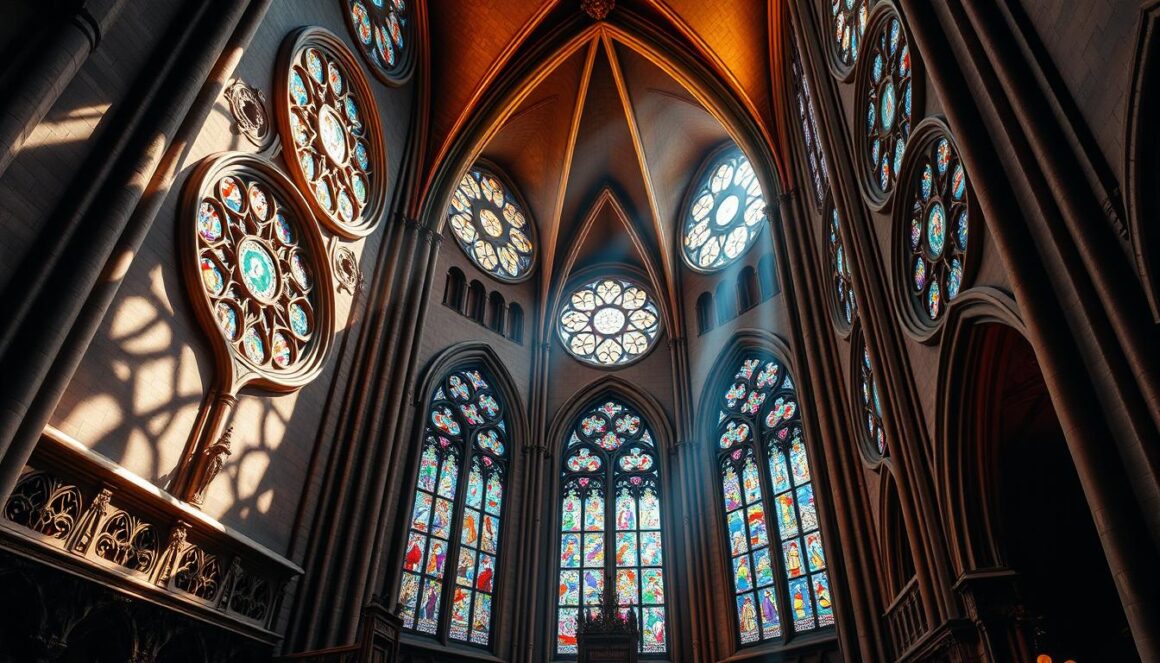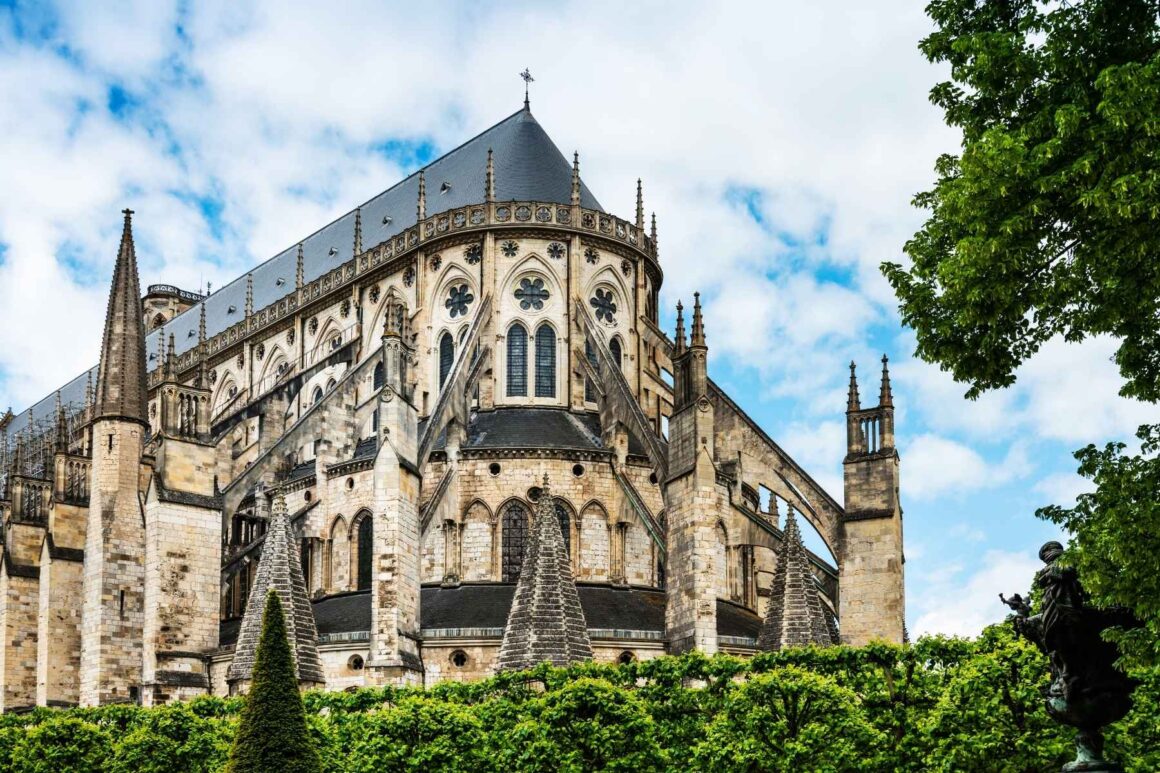Stepping into a Gothic cathedral, you feel awe and wonder. The high spires and detailed stonework take you to another world. These buildings are not just beautiful; they hold deep meanings and symbols.
For years, scholars have uncovered the secrets in these cathedrals. They look at the geometric patterns and how the buildings align with the sky. Every part is designed to give a spiritual experience.
Exploring Gothic cathedrals reveals layers of symbolism. You’ll see numbers and alchemy in the design. These places invite you to discover secrets hidden in stone for centuries.
Key Takeaways
- Gothic cathedrals are filled with symbolism and hidden meanings in their design.
- Geometric patterns, numbers, and sky alignments were added to these sacred places.
- Features like spires and rose windows symbolically connect heaven and earth.
- Gargoyles and other carvings act as guardians and symbols in the cathedrals.
- Studying sacred geometry and alchemy uncovers more meaning in Gothic cathedrals.
Origins of Gothic Architecture
Gothic architecture showed the power of medieval spirituality and skill. It started in 12th-century France, growing from Romanesque architecture. Gothic cathedrals aimed to show divine order and awe worshippers.
The Abbot Suger, known as the father of Gothic architecture, wanted to create “luxe nova” or “new light.” He aimed to make spaces that took viewers from earth to heaven.
This change spread across Europe, marking the landscape and imagination. Gothic buildings used pointed arches, ribbed vaulting, and flying buttresses. This allowed for taller, thinner structures.
The west façade of Gothic cathedrals featured two towers, a central rose window, and three entranceways. This added to their grandeur.
Rose windows were key in Gothic cathedrals, enabling bigger, more detailed stained glass. Chartres Cathedral, finished early in the 13th century, has stunning medieval stained glass. This shows the art and skill of the time.
Gothic architecture kept growing and changing in places like England and Belgium until the 16th century. It shaped the design of churches and university buildings for many years.
The Symbolism of Gothic Spires

Gothic spires are more than just buildings; they symbolize humanity’s quest for the divine. They reach for the sky, showing our desire to connect with something greater. The spires of Notre-Dame Cathedral in Paris, for instance, represent the soul’s journey towards God.
They also symbolize the church’s role as a bridge between earth and heaven. This is a key part of medieval Christian beliefs.
In the 12th century, spires started as simple, four-sided roofs. But by the 14th century, they became taller and more slender. The spire of Fribourg (Switz.) cathedral, at 385 feet, shows the grandeur of Gothic spires in the 19th century.
“Gothic architecture is designed to draw the viewer’s eyes upwards in contrast to Classical architecture focused on balance and human order.”
Gothic buildings, with their arches and points, guide our gaze upwards. This invites us to think about the divine. Notre Dame de Paris, with its high towers and bells, is a symbol of spiritual power.
The Middle Ages believed in reaching God through spiritual ascent. Gothic cathedrals were built to help people feel closer to the divine.
Gothic cathedrals mix reason and contemplation. They show intricate carvings, stained glass, and tall architecture that symbolize the divine. These symbols continue to inspire and captivate those who seek to understand their spiritual significance.
The Rose Window: Beyond Aesthetics

The rose window is a standout feature in Gothic cathedrals. These circular windows are found at the west, north, and south ends. They symbolize the Virgin Mary, known as the “rose without thorns.” The windows in places like Notre-Dame show the deep spiritual devotion behind them.
These windows are more than beautiful. They symbolize the universe’s order and the divine light that shines on us. The detailed designs often tell stories from the Bible or show important religious figures. This helped the mostly illiterate people of the medieval times understand their faith.
The making of these windows is a testament to medieval artisans’ skill. They used top-quality glass from places like Normandy and Lorraine. They also had special tools for cutting and shaping the glass.
They used vitreous paints for the fine details and fired the glass in kilns. This made the colors last longer.
Keeping these windows in good shape is now a big challenge. Restorers use careful cleaning and replace broken glass. They also make sure the windows stay strong. New methods like isothermal glazing help keep these wonders alive for future generations.
The Labyrinthine Floor Plans Explained

Gothic cathedrals have floor plans full of symbols. They are shaped like a cross, with the entrance at the base. This represents Christ’s sacrifice. Walking from west to east, you move from death to rebirth, mirroring the soul’s journey.
The transept, the cross’s horizontal part, shows scenes from the Bible. Its windows tell stories of the Old and New Testaments. The floor plans, with their labyrinths, offer a deep, spiritual experience.
“The labyrinth served as a symbolic entry point into the Celestial City of Jerusalem, communicating complex theological meanings to the illiterate people of the time.”
The central rose in the labyrinth stands for love and union with God. It also represents the Virgin Mary and the Holy Spirit. A hidden star, symbolizing Christ and his disciples, is also part of the design. The lunations around the edge relate to the lunar cycle, linking the cathedral to the divine and nature.
The labyrinth’s place in the cathedral is meaningful. It’s often aligned with sacred geometry. For example, the West Rose Window of Chartres Cathedral fits over the labyrinth, showing the connection between life and the Last Judgement. These designs offer a deep spiritual and contemplative journey through these Gothic wonders.
Gargoyles: Guardians or Grotesques?

Gargoyles sit atop Gothic cathedrals, captivating visitors for centuries. They are both practical and symbolic, rooted in medieval times.
In medieval Europe, gargoyles were used to manage rainwater, protecting buildings from erosion. They also kept evil spirits away, reminding people of the dangers of sin.
The gargoyles at Notre-Dame Cathedral in Paris are famous examples. Many have been replaced, but their presence still amazes. Even after the 2019 fire, they stood strong, symbolizing the cathedral’s spirit.
But not all are true gargoyles. Some are just for looks, called “grotesques” or “chimeras.” They show the mix of function and beauty in medieval design.
Looking at gargoyles makes us think about good vs. evil and our own fragility. They remind us of the deep symbolism in Gothic architecture.
The Significance of Number Patterns
In Gothic cathedrals, numbers carry deep meaning, showing the medieval belief in divine order through math and geometry. These symbols are part of the architecture, making us think about the hidden meanings in these structures.
The number three, for the Holy Trinity, is seen in doors, windows, and arches. Four stands for the earthly world, and seven for spiritual perfection. The number twelve, for cosmic order, shapes the layout and proportions of many cathedrals.
But there’s more to Gothic architecture than just numbers. Sacred geometry adds a layer of religious iconography. The Golden Ratio, Platonic Solids, and the Flower of Life are used in design. They bring a sense of divine harmony and beauty.
“The very stones are alive with the presence of God, each one representing a deeper truth about the nature of the universe and our place in it.”
When we admire these grand buildings, we’re encouraged to explore their symbolic layers. We find a deep respect for the divine in every detail of Gothic cathedral design.
Decoding Sacred Geometry in Cathedrals

Underneath the stunning spires and detailed carvings of Gothic cathedrals lies a secret world of sacred geometry. Experts believe these buildings use complex math patterns to hide deep knowledge. The golden ratio and Fibonacci sequence are among these patterns, showing the universe’s laws and harmony.
The design of cathedrals shows a deep understanding of math, astronomy, and spirituality. Places like Notre-Dame de Paris and the Alhambra in Spain have amazing patterns. These patterns, like tessellations and fractals, show the beauty of math and design.
“The geometry of Bourges Cathedral was analyzed using computer-aided design, showing tight interlocking and unified designs.”
Circles, squares, and triangles hold special meanings, like unity and balance. Spirals symbolize growth and life’s journey. By understanding these symbolic elements, we learn more about the medieval world and architectural symbolism.
Looking into the sacred geometry of cathedrals makes us curious about math and creativity. It also helps us appreciate the cultural and historical value of these buildings. As we explore these patterns, we discover the deep beliefs and insights that shaped these iconic structures.
Wrapping up
Gothic cathedrals are lasting symbols of medieval times. They show off incredible craftsmanship and deep knowledge. Every part of these buildings is filled with meaning.
These structures amaze and inspire us. They let us see a world where art, faith, and wisdom meet beautifully.
Exploring these buildings, you’ll find hidden messages in stone and glass. The symbols in gothic cathedrals, from icons to details, make us think deeply. They show the skill and hard work of their creators.
These spaces were made to lift our spirits and bring us closer to the divine.
If you love learning, art, or just the mysteries of history, you’ll be drawn to gothic cathedrals. They take us to a place where the physical and spiritual blend. Here, the past and present meet, and human beauty shines in the most beautiful ways.




